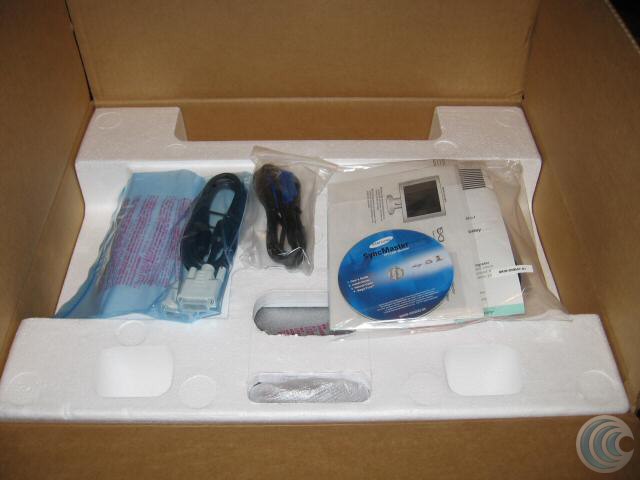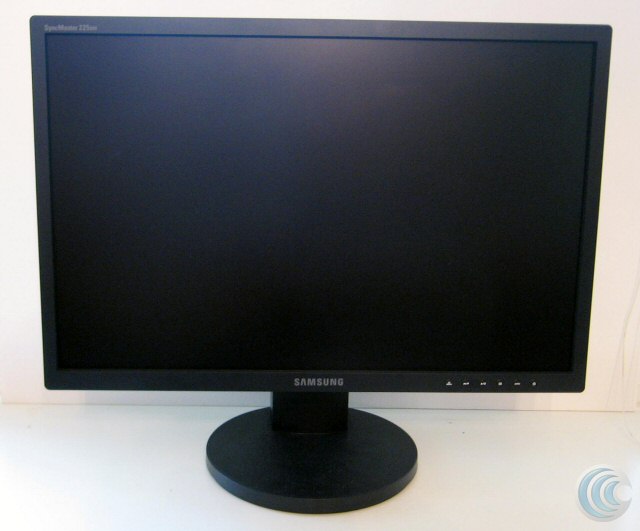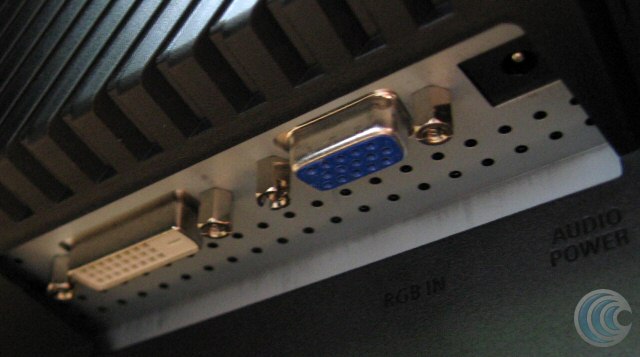Supplied by Samsung
Article updated (10/16): We incorrectly speculated about the panel type in the monitor. There appears to be conflicting information circulating about the panel type, and the article has been modified to reflect this. Our apologies for the confusion.
Introduction
There is no question that LCD panels have come a long way over the last couple of years. Prices have dropped sharply, and 16:10 widescreen displays are becoming all the rage. Despite having used many LCD panels, my main rig still consists of a 70 pound 21 inch CRT. I, like many others, have been waiting for a big and affordable LCD to hit the market. When Samsung offered to let me review their soon to be released 22″ 225BW I could not resist.
The Samsung 225BW is a bit of an odd-ball at twenty two inches. Twenty and twenty four inches have traditionally been the widescreen choices available so it is great to see an offering right in the middle. The 225BW is part of Samsung’s ‘B’ series of monitors, which seem to target the every-day consumer and home user. The models in this family are priced accordingly.
Perhaps one of the first things you’ll notice about the 225BW (aside from its large size) is its price. Twenty two inches for only $399US ($499CDN) is a very competitive price. If the monitor’s performance is as good as its price, Samsung is bound to have a winning panel in their lineup.
Specifications (taken from Samsung.com press release):
- Screen Size: 22 inches
- Aspect Ratio: 16:10 (Standard PC Widescreen)
- Resolution: 1680×1050
- Colors: 16.7 Million
- Brightness: 280cd/m2
- Contrast Ratio: 700:1
- Response Time: 5ms
- Viewing Angle: 160°/160° (CR>5)
- Inputs: Analog RGB,DVI Digital Link (with HDCP support)
- Special Features: MagicBright2, MagicColor and MagicTune.
On paper, the 225BW looks to be a very impressive monitor, sporting features like an ultra-fast 5ms response time and future-friendly HDCP support. The 225BW continues to use a 1680×1050 resolution, which is a resolution commonly used by 20″ widescreen displays. At an extra two inches in size, each pixel will be a bit larger than 20″ monitors like the SyncMaster 205BW or the Dell 2007WFP. I would imagine that a move up to 1920×1200 would also greatly increase the cost of the panel, so 1680×1050 seems like a logical choice.
There is not a whole lot of information on the panel used in the 225BW and there is a lot of conflicting information on the net. There have been some individuals who have dismantled the monitor and found a Chi Mei Optoelectronics M220Z1-L01 panel.
TN (Twisted Nematic) panels are best known for their quick response time, but generally lack in other regards, such as viewing angles and color accuracy. Special films are often employed to improve viewing angles. It is noteworthy that the 225BW is the only widescreen panel in the ‘B’ series that has a specification for the full 16.7M colors. At this time, we are not 100% certain about the panel used in the monitor however, it may be a 6 bit panel using an algorithm to produce the full 16.7M. There is no question that TN panels have matured quite a bit as they were one of the first LCD matrices to hit the market. It will be interesting to see just how well this panel performs.
In The Box
The 225BW came packaged in a fairly plain cardboard box, but was packaged very well. There is a protective piece of padding used to ensure that the panel face is supported and ding-free. If the box is perforated, this will also help to keep the panel safe. A great addition.

Inside the box, I found the following:
- 1x LCD Monitor
- 1x Analog VGA (D-SUB) cable
- 1x DVI cable
- 1x Standard AC Power Cable
- 1x Driver/Software CD
- 1x Warranty Card
The Monitor
The monitor itself is a very aesthetically pleasing display. It has a bit of a minimalist look to it, which appeals to me. The bezel is very narrow, and gives it a very low-profile appearance.

Although it may not have the same jaw-dropping effect as the 2405FPW or the SyncMaster 244T, it does look significantly larger than 20″ widescreen displays.

The monitor appears to use standard ISO mounts, so you should have quite a few after-market mounting possibilities with the 225BW. The stand has a very small footprint but supports the monitor very well. Aside from the usual ’tilt’ adjustment common to just about every monitor, the 225BW also allows for height adjustment and left/right swivel. These features are not commonly found in budget-minded LCD panels.

As you can see, all of the ‘useful’ ergonomic adjustments are supported by the 225BW. Perhaps the only feature missing is 90 degree rotation for a portrait-style orientation. This is usually only found on higher-end monitors and I would not expect to see it on a monitor in this price range. Overall, I was quite impressed by the ergonomics of the 225BW.
Continue to page two: additional features and performance
Inputs consist of the essentials: DVI (With HDCP support) and RGB Analog. I assume that the ‘audio power’ connector is for a speaker add-on of some kind. To my knowledge, there are no accessories available for the 225BW yet. There are no composite, S-Video or Component inputs on the 225BW.

The 225BW employs an internal power supply and connects with a standard computer power cable (included) – no bulky external power bricks required.
Adjustment: I was very pleased to see on-panel controls with the 225BW. Monitors like the SyncMaster 770P moved to a 100% software adjustment model, which I disliked. It is great to have everything at arms reach and to ensure that users of alternative operating systems are still able to adjust the panel.

The OSD (on screen display) of the 225BW is very easy to navigate and provides all of the essential tweaks from brightness/contrast to color tuning.

The ‘MagicBright’ profile system is also very nifty. It allows you to quickly switch between color and brightness presets for various envionments. I found it handy as the high brightness of the 225BW was great for games, but a little hard on the eyes in Windows after a while. Simply press the button second from the left to scroll through the profiles.

Performance
Quite a few LCD reviewers objectively measure performance using specialized tools. I will be trying to look at the monitor from the perspective of an everyday consumer and commenting on performance categories accordingly.
Sharpness: The 225BW produces a sharp image considering its slightly larger pixel size. Text is very easy to read and detail is very evident at the native 1680×1050 resolution. As with most LCDs, lowering the resolution below native results in a significant loss of detail. The 225BW does do a pretty good job of up-scaling from lower resolutions. As you can see below, the larger pixel size is noticeable when up close. You don’t have to move back very far for that to be negligible, however. I personally think the larger screen size more than makes up for the slightly larger pixel size. At less than 20″ away from the monitor, I can not see any pixelation at all.
It should be noted that there were no dead or stuck pixels anywhere on the display.
Brightness: Right out of the box, the brightness level of the 225BW is excellent. Some people may consider it too bright. A simple adjustment can fix that. It is definitely not lacking in this regard.
Color: I found color reproduction to be too ‘cool’ at the default settings. A small boost in ‘red’ greatly improved the issue. The 225BW is really not geared towards graphics professionals but the color reproduction is still quite good with a little tuning.
Viewing Angle: The ‘usable’ viewing angles of the 225BW are quite good. At 45 degrees horizontal, the image is still totally visible with a minor ‘yellowing’ of the image. Vertical viewing angles are also quite good. The color is not quite to the point of inversion at 45 degrees vertical. Obviously, head-on viewing will give you the best color reproduction and clarity but it is nice to know that guests and spectators can still see what you are looking at from a wide variety of angles. Brightness does seem to fade when not looking head-on, but considering that this is a ‘TN’ based panel, I was impressed.

Backlighting and Black Reproduction: I was disappointed to see a significant amount of backlight bleed when viewing anything with a dark image on the 225BW. The bleed was mostly found on the top, bottom and left of the panel. Brightness/Contrast adjustment did little to improve the situation. As you can see below, the bleed is clearly visible with a full black image on screen. It is less evident, but still visible in dark gaming environments and in many video scenes. With brighter images on screen it is difficult to see. Uniformity was also inconsistent across the center regions of the panel. As a result, black reproduction and contrast is negatively impacted. Many panels have varying backlight bleed from one to the next. The very popular Dell 2005FPW is a perfect example of this. Our friends at BCCHardware in Alberta did not see bleed issues to the same extent that we did on our sample. I am hoping that Samsung will work to ensure consistently good backlight uniformity on all 225BWs and that we may have just got a ‘bad apple’. It really should not be that difficult to accomplish without significantly increasing the cost of the unit.
UPDATE 10/22/2006: We have been hearing mixed information about the
backlight uniformity on the 225BWs on the shelves. Please be sure to
stop by our forums

Continue to page three: response time, pricing, and conclusions
Response Time: Being a big fan of FPS gaming, this was not a difficult category to test. I played several hours of fast-paced ‘Day of Defeat: Source’ on the 225BW and it was an absolute joy. This is without a doubt a very fast panel. I saw no ghosting at all–even during the fastest of game play. I don’t have any way of measuring the claimed 5ms gray to gray response time, but it is faster than any LCD I have used to date.

Movies: High definition content and regular DVD content both looked awesome on the 225BW. The quick response time of the panel made movie watching an enjoyable experience. Unfortunately, the backlight bleed issue did take away from the experience during dark scenes.

Gradient Banding: I saw very smooth gradients using both the DVI and VGA inputs, and there were none of the banding issues present in some other new panels.

Pricing and Availability: The 225BW is set to debut at only $399 USD ($499 CDN). This is, without a doubt, an excellent price for a 22″ LCD panel. The 225BW should start hitting the shelves sometime in mid-September. At that price, Samsung will be selling quite a few.
Conclusion
The 225BW is a very capable monitor that has a terrific response time, good picture quality and of course, twenty two inches of widescreen real estate. At a MSRP of only $399 USD, you’ll have a very difficult time finding a better ‘bang for your buck’. I must say that gaming on the 225BW was just awesome—22″ widescreen gaming really needs to be experienced. Every-day computing is also very enjoyable thanks to great brightness, clarity and viewing angles. As an added plus, the 225BW has better ergonomics than many monitors in its price range.
The only flaw that shadows an otherwise excellent monitor is the poor backlight uniformity and bleed that I saw in this sample. Backlight bleed was very apparent at the top and bottom of the panel. As I mentioned in the performance section, this can vary from monitor to monitor and I hope that Samsung will work to ensure consistently good backlight uniformity on all final production model 225BWs.
Overall, I was impressed and if Samsung can sort out the backlight issue, I would definitely recommend the 225BW. Special thanks to Samsung Canada for providing this sample for review. Their continued support of this and other tech-communities is sincerely appreciated.
| Design and Features | ||
| Design, Layout and Ergonomics |
9/10
|
I was very pleased with the ergonomics offered by the 225BW. Height adjustment and swivel capability are not usually offered in budget-minded panels. The design is simple, and attractive. |
| Adjustment and Features |
7.5/10
|
All of the essential adjustments and inputs are present on the 225BW. The OSD is simple and easy to use. HDCP support is a great future-proofing feature also. |
| Presentation/Packaging | 5/5 | Although presentation was a little bland, packaging was great. A buyer can sleep easily while the 225BW is in transit. The extra protective foam was a great addition. |
| Performance Categories | ||
| Sharpness, Brightness and Image Quality |
4/5
|
Even with a larger pixel size, the 225BW has good image quality and produces a sharp image. Brightness is excellent. There is no visible gradient banding. |
| Color Accuracy | 3/5 | Color is too ‘cool’ (blue) and requires some manual adjustment. Once tuned, it does well. |
| Backlighting and Black Reproduction. | 2/5 | Backlight uniformity and bleed was poor on the sample I reviewed. I hope that this issue is limited to my sample and that Samsung corrects this issue in the final production 225BWs. |
| Panel Response Time | 5/5 | The 225BW is a very fast panel and really excels in this regard–a great panel for gaming. |
| Viewing Angle | 4/5 | Viewing angles are excellent on the 225BW. Some color accuracy and brightness is lost when not looking head-on, but overall it does very well in this regard. |
| Price to Performance | ||
| Value |
9/10
|
A lot of monitor, for not a lot of money. |
| Total Score |
48.5/60
|
A total percentage of 81% |
Thank you for visiting Short-Media. Consider registering for our forums and commenting on this review of the Samsung SyncMaster 225BW LCD Monitor.









 Articles RSS
Articles RSS